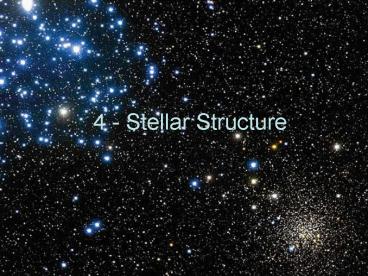4 - Stellar Structure - PowerPoint PPT Presentation
1 / 17
Title:
4 - Stellar Structure
Description:
Mass Conservation (distribution of mass with radius) Hydrostatic Equilibrium (balance of internal ... Thermal Equilibrium (luminous energy versus radius) ... – PowerPoint PPT presentation
Number of Views:58
Avg rating:3.0/5.0
Title: 4 - Stellar Structure
1
4 - Stellar Structure
2
- To build a stellar model, we need to develop a
series of equations - Mass Conservation (distribution of mass with
radius) - Hydrostatic Equilibrium (balance of internal
pressure gradient with gravity) - Thermal Equilibrium (luminous energy versus
radius) - Energy Transport (radiative, convective,
conductive transport) - Equation of State (relating P, T, and ?)
- Opacity to radiative transport
- Energy Generation (nuclear reaction parameters)
2
3
Pressure
Radiation Pressure
Radiation Energy Density
4
Equation of State Gas Pressure
Ideal or Perfect Gas Law
Non-degenerate
For a fully ionized gas (deep interiors)
5
Gas Degeneracy
Non-relativistic Degenerate
Relativistic Degenerate
(both are in cgs units)
6
Equation of Mass Continuity
Note the gravitational potential energy of the
star will then be
7
Hydrostatic Equilibrium
The force downward due to gravity on a mass
element of volume Adr is
The net force outward on the same mass element
due to the pressure gradient is
For equilibrium,
So,
8
Proton-Proton Chain
9
Nuclear Reaction Rates in Stars Proton-Proton
Chain XY1/2, ? 100 g cm-3, T15x106
Energy Liberated (MeV) Reaction
non-neutrino neutrino Lifetime PPI 0.16
0.26 8x109 years 1.02 5.49 1.5
sec 12.86 2.4x105 years 2A2BC?26.2 MeV
in available energy plus 0.5 MeV lost to star via
neutrinos PPII A B and primordial
4He 1.59 106 years 0.06 0.80 0.4
years 17.35 10 minutes 10-16
seconds PPIII ABD 0.13 66 years
10.78 7.2 1 second For Tlt10x106K,
the p-p chain terminates with (B). IF Tgt 10x106K,
(C) also occurs. If Tgt14x106K, PPII and PPIII
contribute, and in fact PPII will dominate over
PPI in the production of energy.
10
CNO Cycle With a sufficient abundance of carbon
and Tcore16x106 K, a catalytic reaction
involving 12C occurs. (Note if Tlt13x106 K, the
cycle time gt age of the Sun (5x109 years)).
11
CNO Cycle solar-like core T15x106K, ?100 g
cm-3, X0.6 shell source of a post-main sequence
5MSun star - T30x106K, ? 26 g cm-3,
X0.2 Energy Time Reaction
non-neutrino neutrino Solar-Like
Shell Source 1.94 1.5x106 yrs 270
yrs 1.51 0.71 14 minutes 7.55 3.7x105
yrs 66 years 7.29 3x108 yrs
1500 yrs 1.76 1.00 3 minutes 4.97 104
yrs 0.6 yrs Net result If Tgt17x106K, an
alternate set of branches can occur 0.3 of the
time.
12
T6 ?(CNO) 20 18.0 30 15.6 40 14.1 50 13.1 60 12.3
70 11.6 80 11.1 90 10.6 100 10.2
T6 ?(PP) 15 3.9 20 3.5 25 3.2 30 3.0
13
3-a Process Helium-burning When He is
abundant, ? 104 105 g cm-3, and Tgt 108K, the
3-a He-burning reaction can occur (Salpeter
1952). The reaction releases 7.27 MeV per 12C
produced. This is often followed by
14
At T gt 6x108K, Carbon-burning occurs
At T gt 1-1.5x109K, Oxygen-burning occurs
15
THE FUNDAMENTAL EQUATIONS OF STELLAR STRUCTURE
16
(No Transcript)
17
(No Transcript)































